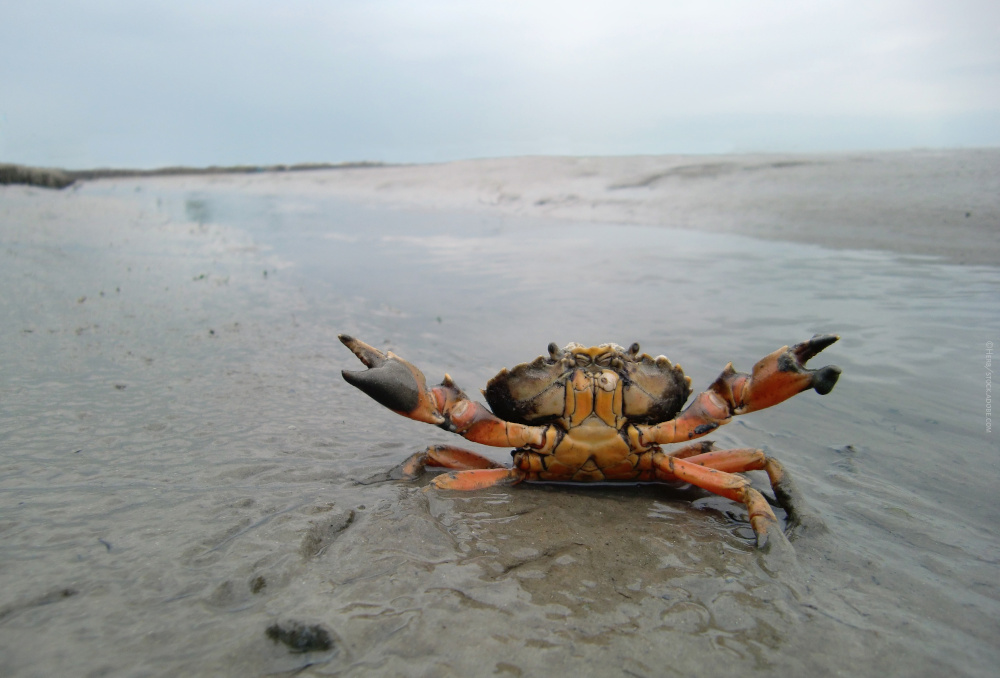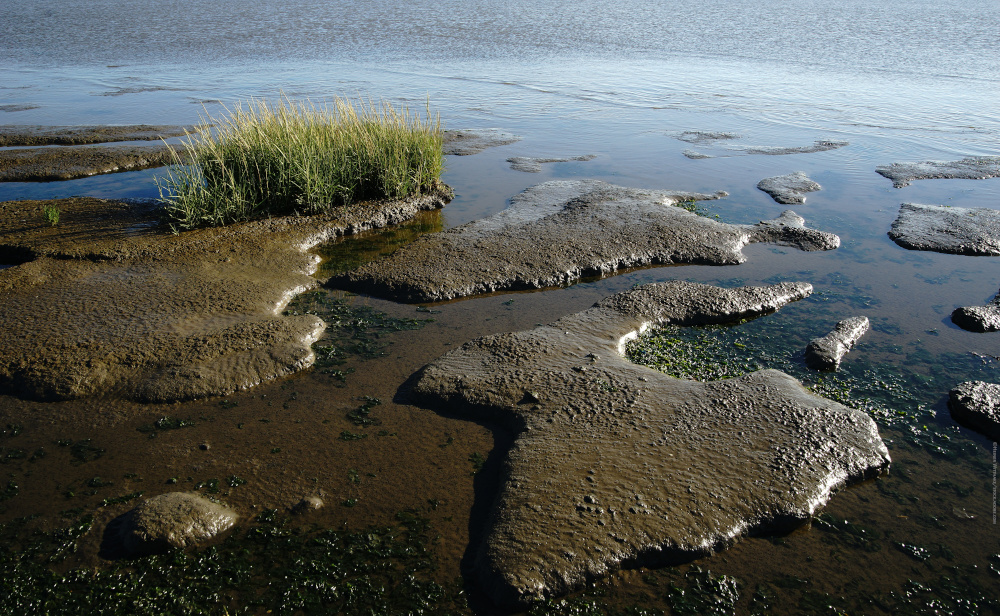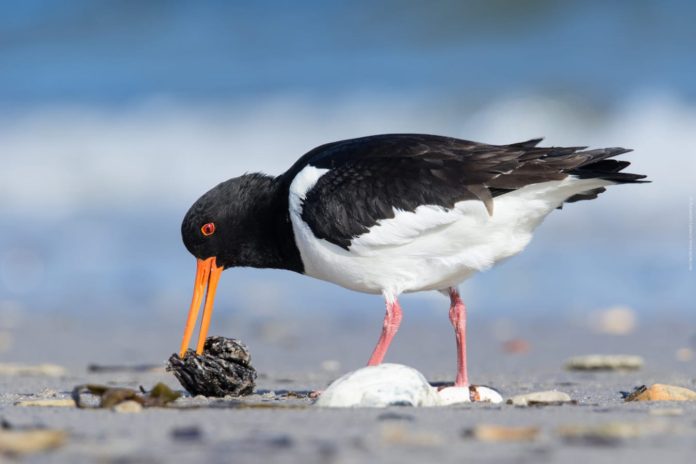Will algae and marine animals imported from overseas remain a problem forever or will they even strengthen the ecosystem against increasing global warming and rising sea levels? Karsten Reise and Dagmar Lackschewitz discuss this in their article from National Park 02-2023.
Biodiversity is decreasing worldwide. But it is increasing in the Wadden Sea. Why? As the world's largest mudflat area made of sand and mud, with feeding grounds for over ten million coastal birds, the Wadden Sea enjoys the highest protection status. The federal states of Lower Saxony, Hamburg and Schleswig-Holstein have declared their sections a national park and, together with the Dutch and Danish parts, the Wadden Sea has been declared a world natural heritage site. Unaffected by this, however, global shipping traffic brings more and more marine organisms across all oceans to the European Atlantic coast and from there to the Wadden Sea.
This started with the Vikings, who brought sand gape mussels with them from North America. Since the last century, ocean-going ships have not only become faster and larger, but above all more. As a result, “stowaways” were carried off around the world in the growth on ship walls and in the tank system for ballast water: in particular algae, mussels, crustaceans and tunicates. The trade in farmed oysters also brought “exotic” oysters unnoticed to many coasts. And from the Ponto-Caspian region, canals between the European rivers allowed immigration into the Wadden Sea.
Even though ocean currents connect all coasts with each other, they vary greatly in the range of species. Climate zones form boundaries, and algae spores and larvae of bottom animals are unable to drift across oceans. Only shipping traffic made an exchange of species possible. Even from the distant Pacific region, more and more organisms are being transported to the Wadden Sea, where over a hundred species now come from overseas. And there are more and more of them, despite preventive protective measures such as regular cleaning of the underwater hull and treatment of ballast water.
The Wadden Sea was naturally poor in species. This is not only due to the changeable tidal conditions, but especially to the strongly fluctuating climate conditions due to the alternation of ice and warm periods in the North Atlantic region. Although mudflats are lushly populated, if a new species is added that can do something the others cannot, it finds its place and is integrated ecologically. Sometimes there is rapid multiplication after arrival, but this then subsides again after a few years. The population size levels off. Integration takes time.
This doesn't always happen without a struggle. While the Chinese mitten crab, which first appeared in the Aller in 1912, remained completely unrivaled in the estuaries of the Wadden Sea because no other crab was found there, a fight broke out at the beginning of this millennium between two other Pacific crab species and the native shore crab.

Competition for living space
At first the introduced people mostly only crawled under the stone packs of the dikes and harbor facilities, but then they also liked the large mussel beds in the Wadden Sea. Young shore crabs of the same size avoid the proximity of the more agile Asians. The adult shore crabs, which are more than twice as large, still have the upper hand, but now have to share their living space with the new crabs. How the dispute will end is unclear.
Pacific oysters were introduced as a culinary substitute for European oysters. They disappeared from the Wadden Sea due to overexploitation long before imports from Japan became widespread. Oyster farmers believed that the northern European coast was too cold for the reproduction of new oysters fattened in the Wadden Sea – in mesh bags on racks. But it got warmer and their plankton larvae found ideal conditions to attach in the mussel beds. There they grew into oysters, on average three times as large as their relatives in the Korean mud flats.
At first it seemed that the rapidly growing oysters would push the mussels from their beds. But then more and more oysters grew on and on top of each other. Complex reef structures anchored deep in the ground emerged. In turn, their niches now offer mussels protection from crabs and birds, creating a highly stable community that is resistant to storms and ice floes. In addition to the Pacific oysters, the new reefs are now home to around twenty other species from overseas, without any of the long-established ones disappearing. Biodiversity increased everywhere in the Wadden Sea. Removing the new ones is hardly possible in the sea. It is also questionable whether this would even be desirable.
Adaptation to new circumstances
What has changed? A hundred years ago, the primary goal was to convert the “useless and desolate” mudflats into land for livestock breeding and agriculture. A newly formed grass on the banks of the English Channel was just right for this. A mud grass arrived from the North American coast in ship ballast and crossed with a European species. By doubling the chromosomes, a particularly vigorous new species emerged, which was planted in the Wadden Sea for “land reclamation”.
Slowly at first, but as the North Sea coast became warmer, the new mudgrass gained land at increasing speed. A lot of silt accumulates between the dense and towering growth, which is held in place by a dense and durable root system. The growth usually remains patchy and the native vegetation even benefits from the new neighbor, which stabilizes the mudflats.
Only in the last few years have two new tubular algae of unknown origin appeared far out in the Sylt mud flats, where the sandbanks only appear briefly during spring tide. In contrast to the mud grass, they are completely inconspicuous. But they change the mudflats due to their dense growth. Where there was rippled sand, silt up to eight centimeters high accumulates. This is caused by the hair-thin green algae threads protruding close together from the mudflats and matted together underground. All the fine particles carried by the tide get stuck between the tubular algae.
Silt grass, tubular algae and oyster reefs with mussels consolidate the mudflat bottom and increase it. This can help preserve the Wadden Sea naturally if global warming causes sea levels to rise by around one meter in the next hundred years. The new ones could also prove useful in keeping up with global warming. Since the Wadden Sea is located further north and is therefore cooler than other coasts from which most ships come, almost all of the organisms carried along are already well adapted to warmer conditions. Species also migrate from the south through natural expansion. But this will take longer than is now required by the average temperatures in water and air, which have increased by one to two degrees over the last forty years.

Newly understood ecosystem
The flood of species from overseas and their interference with native communities has, as a side effect, helped ecological science to gain new insights. Today, twice as much North Sea water is filtered through introduced species: American slipper snails and razor clams, Pacific oysters and Manila clams, barnacles from Australia, numerous tunicates from East Asia, all of them, as filter feeders, feed on what is produced by plankton in coastal water. This has also increased, fertilized by the excessive nutrient loads that flow from the land into the North Sea via the rivers. But even without this additional production, it is clear that the Wadden Sea is an open and unsaturated ecosystem. There is no closed society there that keeps strangers away.
The ecological integration capacity is astonishing. It has noticeably increased the diversity of species and biotopes and strengthened the performance of the ecosystem. The new ones are expected to help with adaptations to rising seas and warmer climates. Introduced worms and mussels provide additional food for wading birds threatened by climate change. Especially the long-haul fliers among them – who breed in the Arctic and overwinter in West Africa – need more food in a shorter time at their stopover in the Wadden Sea due to the premature melting of snow in the north.
What do we learn from this?
All in all, the effects of the species that have been transported from their areas of origin in the Wadden Sea are better than their reputation. That doesn't mean that there can't be threatening organisms among them, just as the introduced fungi severely affect European elms and ash trees or rats on oceanic islands steal all their clutches from breeding birds. Protective measures are therefore necessary, even if nothing similar has happened in the Wadden Sea to date.
What should change, however, is the blanket and persistent rejection of the now ecologically integrated species from overseas. They have found their place and have become part of nature. They are just as natural in everything they do as other species. Nature does not suffer from them, but is enriched. The ecological network in the Wadden Sea World Heritage Site has become more fine-meshed, and over a hundred immigration stories connect us with this amazingly integrative nature.


